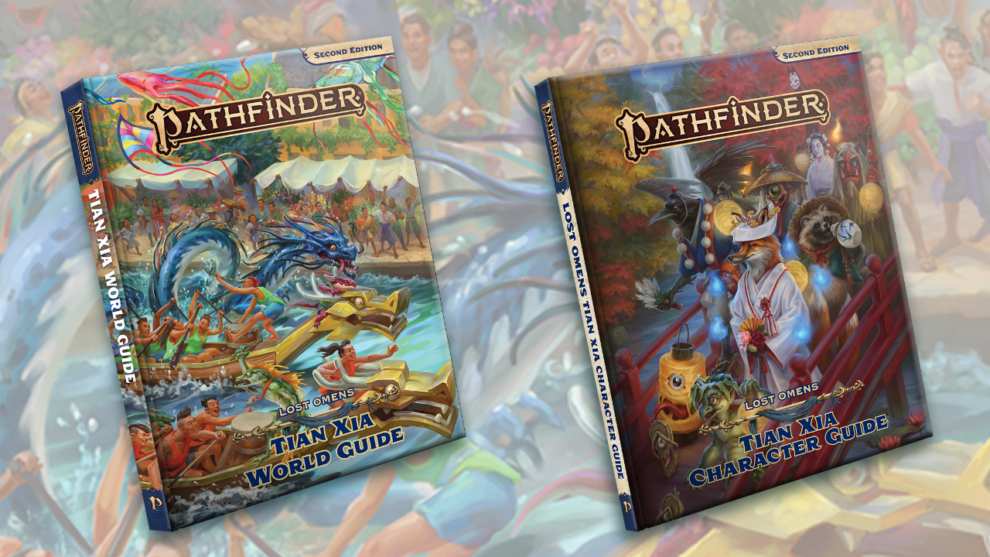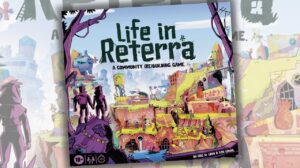Disclosure: Meeple Mountain received a free copy of these products in exchange for an honest, unbiased preview. This preview is not intended to be an endorsement.
When people think of high fantasy role playing games, the imagery that often comes to mind is that of a sword-wielding warrior or a wizard blasting spells at a dragon. However there is so much more to see beyond the fantasy viewed through a European lens. Fantasy is a global concept, although it’s important that drawing from unfamiliar source material is done considerately through the use of cultural consultants or first-hand experience. Paizo’s development of the Tian Xia region has redefined what it means to be respectful to source material while adapting it for their Pathfinder setting.
Tian Xia World Guide Overview
Tian Xia is one of Golarion’s massive continents, embraced by the Embaral and Okaiyo Oceans. Most of the familiarity with Pathfinder’s setting is dominated by the regions of Avistan, which includes Varisia, Belkzen, and my personal favorite—Galt. It may be a different atmosphere than the settings of many of Paizo’s Adventure Paths, but its influence on the world at large is noticeable.
The majority of the Tian Xia World Guide was written by people of Asian descent. Therefore, its pages offer perspectives based on experiences and ideas that are based on real Asian history and its culture. It is important to note that despite the obvious care and attentiveness that has gone into the book, all of Asian culture and history cannot be contained in a single volume—these viewpoints have shaped Golarion’s Asia analog in the most respectful way possible while covering tons of regional ground.
This is primarily a setting book, meaning that the contents offer insight into the rich history, religion, and culture of the nations therein. It’s impossible for me to offer comments on everything included, so I will be focusing on the broad strokes of the guide so that you can determine if it’s something that would interest you.
The authors start by outlining the five essential points on what makes Tian Xia different from other continents like Avistan. This is a great basis for setting aside preconceptions about what you think you know about this area, and serves as sound advice for new characters preparing to adventure in the continent. As a Gamemaster, it is definitely something that I’ll emphasize as a part of any Session Zeros involving Tian Xia. In brief, these are:
- Celestial aren’t always good
- Appearances are deceiving
- Dragons aren’t monsters
- Spirits aren’t abstract
- The dead are never truly gone
What really impresses me about the Tian Xia World Guide is how every nation has so much life and detail breathed into it. Take, for example, the free city of Kutaban. Nestled on the northern edge of the Valashmai Jungle, it’s described as a gateway into the jungle, where riverboats and cargo flow freely along the river. Although it could have been left at that, the authors go on to describe how the crocodilian sovereign, Sujana Mahad, maintains the peace and order between the merchant lords that wish to stake their claims through the wilderness. Oh, and the city is also set amongst the giant ribcage of a dead kaiju, the enormous beasts of unknown origin.

That is precisely how this book is written, with intentionality and creativity poured from pen to page. There’s the witch-queen spider woman, Lady Lang Loi, who rules the gloomy nation of Shenmen. Or perhaps consider the grave of Moyoshi Shoda, a legendary hobgoblin warlord whose war philosophy of preserving lives became the structure for culture in Kaoling. Instead, maybe, you’d be interested in the empty throne in Po Li, where the inhabitants await the reincarnation of the Eternal Emperor of Lung Wa.
Besides the unbelievable amount of detail presented in the Tian Xia World Guide, the format of the book deserves mention for its consistency and care. Every location entry has a synopsis, information on geography, description of a day in the life there, what a year in the area looks like, cultural description, details on government and notable people, cities, and locations within. It truly gives a broad and deep understanding, where you can read a few pages and come away with the knowledge of how each region’s point of reference has shaped their point of view.
I’ve also found the copious number of tooltips to be exceedingly helpful. Many of the sections have a pronunciation guide in the margins so that readers don’t need to make guesses. Important concepts and references are bolded so if a specific piece of art catches your eye you can find the place in the text that discusses it. I’ve talked at length about how Paizo is the gold standard when it comes to layout, and between the sidebar, index, and glossary, it is exceptionally easy to find information.
Although the Tian Xia World Guide is a book primarily geared towards Gamemasters to help understand the setting, I do think there is immense value in players picking this up as well. It’s important for people to consume literature, media, and art that is varied and deriving from a multitude of backgrounds. This helps in offering new perspectives and angles of thinking that allow us to be better global citizens with a comprehensive worldview.
Can a tabletop roleplaying game sourcebook for Pathfinder really do that? It’s just a game, after all.
Yes—it really can.

Tian Xia Character Guide Overview
Just as the Tian Xia World Guide is mainly designed for Gamemasters, the Tian Xia Character Guide is primarily for players who wish to either play in the setting or utilize any of the many options within. It’s interesting because the introduction to the book boils down the general concept of the World Guide into a handful of pages, so you’d have to reference that setting-specific volume to get additional details on the world-at-large.Organizing this book with the player-based audience in mind, Paizo has shifted the grouping of their information so that it’s easily accessible. Whereas the World Guide had several areas where you might find details on Vanaras or Ysoki in Tian Xia, there’s a complete section outlining the peoples, so that if you’re interested in a particular group of people you don’t have to scour the book. It’s all in one place.
The same is true of the magic and spirits in the continent, which is also a condensed version compared to the Tian Xia World Guide. I think the rehashing of the material does a disservice to the scope tackled in the World Guide because you lose some of the region’s full picture. On the other hand, if Paizo isn’t expecting players to pick up both guides, it is important to have at least a fundamental understanding of the basics when creating characters based in Tian Xia.
My favorite part of the book, hands down, is the story of Tian Shen, who conquered the 12 Impossible Trials of the Zodiac which is central to the overarching culture of Tian Xia. From the perspective of the Tian Xia Character Guide, the Zodiac exists as a similar analog to the Chinese Zodiac in the sense that it provides suggestions into the temperament, fortune, and other characteristics of a person. However, the book goes into detail about the Trials that Tian Shen overcame that immortalized his heroic actions forever. It is well worth the read. There’s even a rare background centered around it.

The Tian Xia Character Guide contains 20 new backgrounds for you to incorporate into your characters. They range in mundanity and scope, from a Jeweler all the way to a Kaiju Stalker, which reminds me of a character one of my players had in Rise of the Runelords whose background was in slaying mythical beasts. If you’re looking for a foundation on which to build a new character in Tian Xia, there is plenty to appreciate here.
Additionally, 16 character heritages await, ranging from the magical kitsune to the racoon-adjacent tanuki. But let’s not overlook the fact that a playable heritage is now a tsukumogami poppet, which are a type of spirit embodying common household objects. You may recognize them from their inspiration as yokai from Japanese folklore, and they were actually originally introduced to the Pathfinder world through the Lost Omens Grand Bazaar book. Taking this heritage would require plenty of communication with the GM as it can present some challenges in a typical adventure, but it is also a really interesting avenue to explore as a character.
Roughly a quarter of the book is dedicated to other character options, including various dedications and their respective feats, spells, and other mechanical additions to your characters. Most of these have a distinctive Tian Xia flair to them, like the Five-Breath Vanguard who is an elementalist from the School of Five Breaths. Others seem more generic, but emphasize topics of importance to Tian Xia culture like cooking feats through the Wandering Chef dedication or Pei Zing herbalism and its usage in elemental medicine.
I would be remiss if I didn’t include my favorite entry in the book, which is the Cultivator archetype. Following suit with what I typically gravitate towards, the cultivator is brimming with flavor. Essentially, cultivators seek immortality, whether that be a path clad in holiness or the opposite. The feats are so choice with names like Three Clear Breaths, Lotus Above the Mud, and The Bitter Scholar’s Promotion. I’m entrenched in this idea that a character is obsessed with regimenting their body and mind to achieving a form of pseudo-divinity, and that at some point they come to a fork in the road that can lead them down completely different paths.
The Tian Xia Character Guide is perfect if you’re planning on playing a character in the Tian Xia region or if they have roots there. There is no end to the amount of character concepts, and there are plenty of mechanical choices to supplement any ideas that you may have gotten from the Tian Xia World Guide.

Tian Xia Lost Omens Guides: Ambition Incarnate
Any time that you’re trying to create a setting guide, the scope is immense. Even in the case of the Tian Xia Lost Omens Guides where you have pre-existing content from previous interactions to build on, it is a completely different kind of operation to go into the project to fix any insensitivity or inattentive aspects of that content. Paizo set out to ensure that there was obvious care and intentionality around Asian cultures in developing this latest iteration of Tian Xia for Pathfinder Second Edition, and it is so clear and apparent that these two books are a direct expression of shared experience.
Whether you are a Gamemaster or a player, understanding the importance of thoughtfully portraying cultures is paramount, and the pair of Tian Xia Lost Omens Guides is a prime example of ensuring things are done respectfully as a celebration of perspectives.










